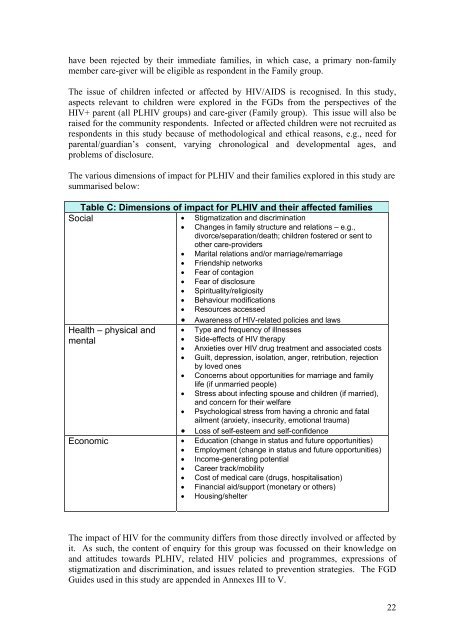Download this publication - AIDS Data Hub
Download this publication - AIDS Data Hub
Download this publication - AIDS Data Hub
Create successful ePaper yourself
Turn your PDF publications into a flip-book with our unique Google optimized e-Paper software.
have been rejected by their immediate families, in which case, a primary non-familymember care-giver will be eligible as respondent in the Family group.The issue of children infected or affected by HIV/<strong>AIDS</strong> is recognised. In <strong>this</strong> study,aspects relevant to children were explored in the FGDs from the perspectives of theHIV+ parent (all PLHIV groups) and care-giver (Family group). This issue will also beraised for the community respondents. Infected or affected children were not recruited asrespondents in <strong>this</strong> study because of methodological and ethical reasons, e.g., need forparental/guardian’s consent, varying chronological and developmental ages, andproblems of disclosure.The various dimensions of impact for PLHIV and their families explored in <strong>this</strong> study aresummarised below:Table C: Dimensions of impact for PLHIV and their affected familiesSocial • Stigmatization and discrimination• Changes in family structure and relations – e.g.,divorce/separation/death; children fostered or sent toother care-providers• Marital relations and/or marriage/remarriage• Friendship networks• Fear of contagion• Fear of disclosure• Spirituality/religiosity• Behaviour modifications• Resources accessed• Awareness of HIV-related policies and lawsHealth – physical andmental• Type and frequency of illnesses• Side-effects of HIV therapy• Anxieties over HIV drug treatment and associated costs• Guilt, depression, isolation, anger, retribution, rejectionby loved ones• Concerns about opportunities for marriage and familylife (if unmarried people)• Stress about infecting spouse and children (if married),and concern for their welfare• Psychological stress from having a chronic and fatalailment (anxiety, insecurity, emotional trauma)• Loss of self-esteem and self-confidenceEconomic • Education (change in status and future opportunities)• Employment (change in status and future opportunities)• Income-generating potential• Career track/mobility• Cost of medical care (drugs, hospitalisation)• Financial aid/support (monetary or others)• Housing/shelterThe impact of HIV for the community differs from those directly involved or affected byit. As such, the content of enquiry for <strong>this</strong> group was focussed on their knowledge onand attitudes towards PLHIV, related HIV policies and programmes, expressions ofstigmatization and discrimination, and issues related to prevention strategies. The FGDGuides used in <strong>this</strong> study are appended in Annexes III to V.22















